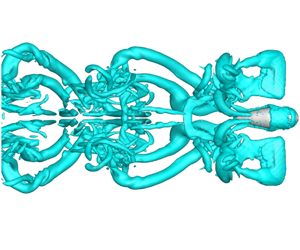Article contents
Forward flight and sideslip manoeuvre of a model hawkmoth
Published online by Cambridge University Press: 04 June 2020
Abstract

This paper presents a computational study on the free forward flight and sideslip manoeuvre of an insect-like flapping-wing flyer modelled after the hummingbird hawkmoth (Macroglossum stellatarum), with Reynolds number  ${\sim}3000$. The numerical model integrated a Navier–Stokes fluid solver with the Newtonian free-body dynamics of the flyer. A generic proportional–integral–derivative (PID)-based wing kinematics controller was used to achieve stable controlled flight. State-equation analyses of flight dynamics were helpful in identifying the roles of kinematic wing actions and for establishing control coefficients for stable flight. Forward flights up to a speed of
${\sim}3000$. The numerical model integrated a Navier–Stokes fluid solver with the Newtonian free-body dynamics of the flyer. A generic proportional–integral–derivative (PID)-based wing kinematics controller was used to achieve stable controlled flight. State-equation analyses of flight dynamics were helpful in identifying the roles of kinematic wing actions and for establishing control coefficients for stable flight. Forward flights up to a speed of  $4.3~\text{m}~\text{s}^{-1}$ were simulated, which show that the wingbeat frequency decreased below the hovering frequency for cruising flight in the low- and medium-speed range, and higher frequency was only needed for high-speed flight. Similarly, the aerodynamic power consumption was also lower than that for hovering flight over the simulated speed range, due to the contribution of wing drag to overall lift. In addition, flight with higher speed tends to be more efficient in terms of energy consumption for the same distance travelled. In a complete sideslip manoeuvre, the model hawkmoth took approximately 20 wing cycles to translate laterally 4.5 wing lengths to its right and another 30 wing cycles to stabilize hovering at the new location. Slightly higher wingbeat frequency and power were required during the sideslipping phase to adjust for drop in lift due to body roll. The evolution of the vortical wakes reflects quite well the major mechanisms of force generation that were at play at key stages in these flights.
$4.3~\text{m}~\text{s}^{-1}$ were simulated, which show that the wingbeat frequency decreased below the hovering frequency for cruising flight in the low- and medium-speed range, and higher frequency was only needed for high-speed flight. Similarly, the aerodynamic power consumption was also lower than that for hovering flight over the simulated speed range, due to the contribution of wing drag to overall lift. In addition, flight with higher speed tends to be more efficient in terms of energy consumption for the same distance travelled. In a complete sideslip manoeuvre, the model hawkmoth took approximately 20 wing cycles to translate laterally 4.5 wing lengths to its right and another 30 wing cycles to stabilize hovering at the new location. Slightly higher wingbeat frequency and power were required during the sideslipping phase to adjust for drop in lift due to body roll. The evolution of the vortical wakes reflects quite well the major mechanisms of force generation that were at play at key stages in these flights.
JFM classification
- Type
- JFM Papers
- Information
- Copyright
- © The Author(s), 2020. Published by Cambridge University Press
References
- 17
- Cited by


